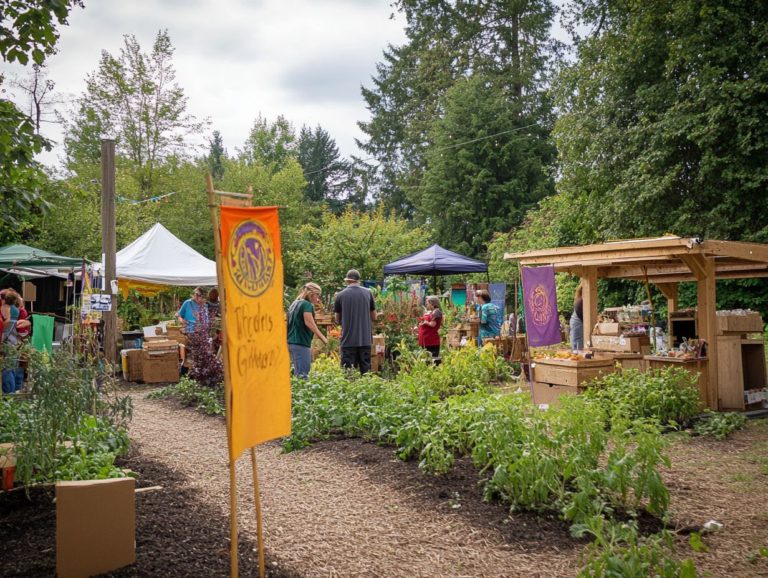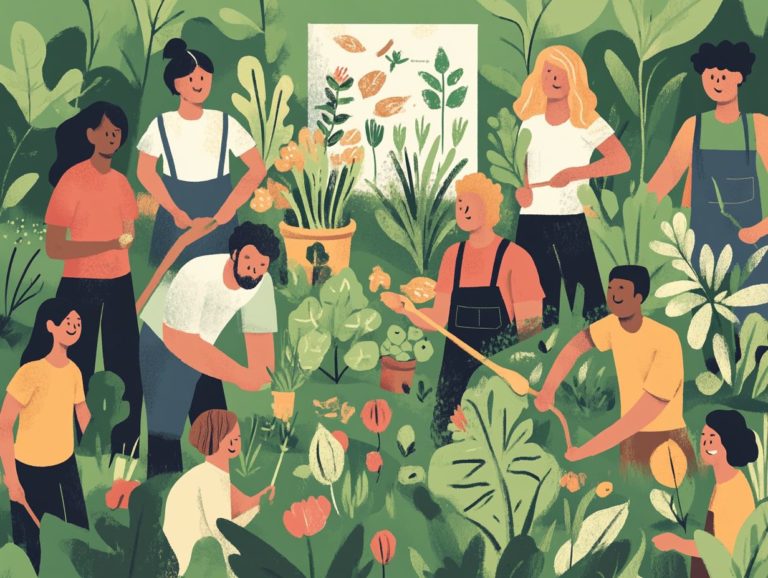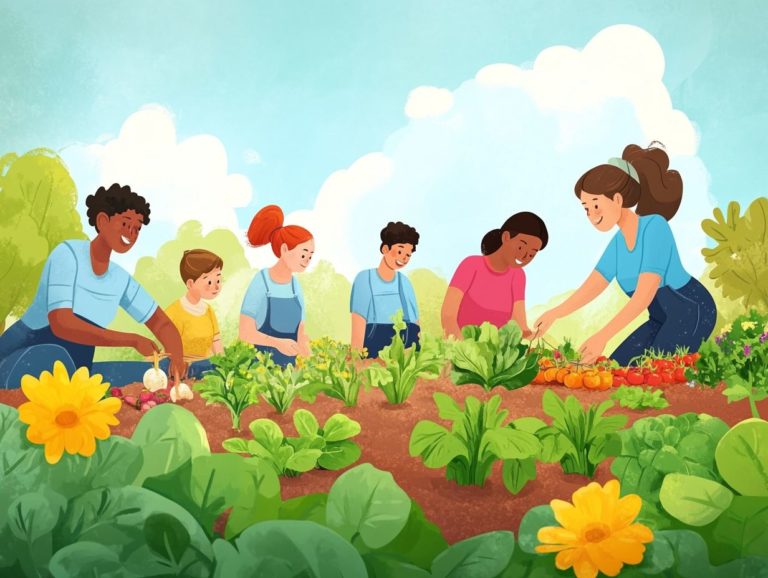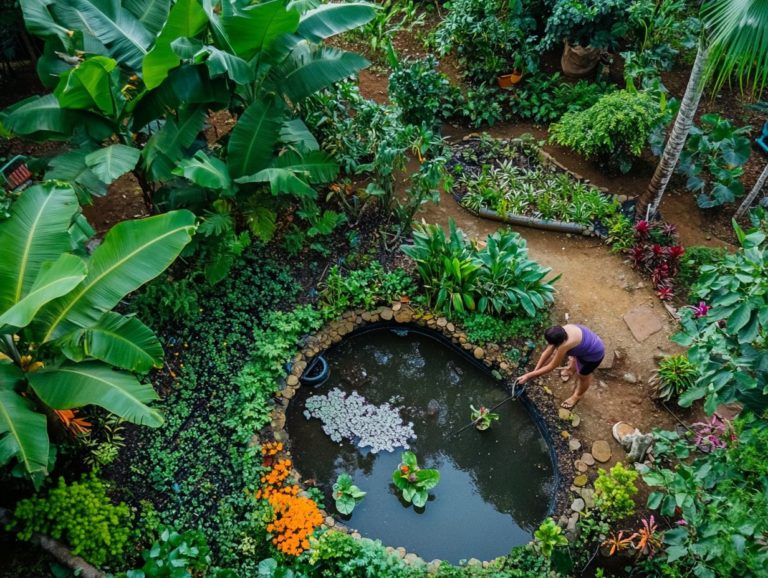4. 7 Essential Permaculture Books for Beginners
Get ready! Here are seven must-read books that will jumpstart your permaculture journey. Permaculture offers great ways to live sustainably, seamlessly weaving together agriculture and ecology.
These essential books act as invaluable guides for beginners eager to embrace this holistic approach. From foundational texts like “Gaia’s Garden” by Toby Hemenway to groundbreaking ideas in “The Permaculture City”, each book provides profound insights into creating resilient systems.
Whether you’re a novice gardener or an aspiring homesteader, these resources will inspire you to cultivate a thriving environment that nurtures both people and nature.
Contents
- Key Takeaways:
- 2. Gaia’s Garden by Toby Hemenway
- 3. The One-Straw Revolution by Masanobu Fukuoka
- 4. Permaculture: A Designer’s Manual by Bill Mollison
- 5. The Resilient Farm and Homestead by Ben Falk
- 6. Sepp Holzer’s Permaculture by Sepp Holzer
- 7. The Permaculture Handbook by Peter Bane
- 8. The Earth Care Manual by Patrick Whitefield
- 9. Permaculture: Principles and Pathways Beyond Sustainability by David Holmgren
- 11. The Holistic Orchard by Michael Phillips
- 12. The Permaculture Orchard by Stefan Sobkowiak
- 13. The Permaculture City by Toby Hemenway
- 14. The Art of Natural Building by Joseph F. Kennedy
- 15. The Permaculture Way by Graham Bell
- What Is Permaculture and Why Is It Important?
- Frequently Asked Questions
- What are the 7 essential permaculture books for beginners?
- Why should I read these books as a beginner in permaculture?
- Which book should I start with as a beginner in permaculture gardening?
- Is permaculture only applicable to gardening?
- Are these books suitable for all levels of experience in permaculture?
- Can I find these books in different formats?
Key Takeaways:

- Discover how key principles of permaculture can change your life through books by experts like Bill Mollison and David Holmgren.
- Explore the benefits of permaculture for the environment and communities with titles like Gaia’s Garden and The Resilient Farm and Homestead.
- Learn how to incorporate permaculture into your daily life with practical guides like The Permaculture Handbook and Introduction to Permaculture Design.
2. Gaia’s Garden by Toby Hemenway
In “Gaia’s Garden,” Toby Hemenway invites you to explore the practical applications of permaculture ideas. He highlights the significance of cultivating ecological gardens that promote biodiversity and enhance community engagement.
With insightful illustrations and real-life examples, Hemenway clarifies how you can easily integrate these principles into your gardening practices. You re encouraged to assess your local ecosystems and identify the resources available to you. This allows you to create gardens that thrive in harmony with nature s inherent rhythms.
Key strategies include companion planting, which maximizes your space and boosts plant health. Incorporating perennial plants requires less maintenance over time. By fostering community involvement through workshops and shared gardening experiences, you can deepen your connection to the land while promoting sustainable practices that benefit everyone.
3. The One-Straw Revolution by Masanobu Fukuoka
Masanobu Fukuoka’s The One-Straw Revolution transforms your understanding of sustainable agriculture. It advocates for natural farming methods that align beautifully with permaculture and organic farming principles.
His philosophy stems from a profound respect for nature’s processes. By preserving and enhancing the soil s vitality through minimal intervention, you can prioritize biodiversity and adopt a holistic approach to farming. Fukuoka s ideas challenge conventional practices and underscore the importance of nurturing ecosystems instead of merely extracting resources.
This perspective encourages you to cultivate a regenerative mindset. Make every farming decision with soil conservation at the forefront, aiming to restore and rejuvenate land rather than degrade it. The implications of these techniques inspire a cultural shift towards more sustainable and ethical food production.
4. Permaculture: A Designer’s Manual by Bill Mollison
‘Permaculture: A Designer’s Manual’ by Bill Mollison is your go-to resource for grasping the fundamentals of permaculture design. This manual is packed with invaluable insights that elevate sustainable practices and innovative farming techniques.
This manual goes beyond theory, turning ecological principles into actionable strategies. Whether in your home garden or on a larger agricultural scale, it gives you the power to cultivate sustainable environments.
This manual also enriches the educational landscape of permaculture, deepening your understanding of ecological balance, resource management, and community engagement. Ultimately, the principles outlined serve as your guiding compass, steering you toward a greener, more sustainable future.
Dive into these books today and start your journey towards a greener lifestyle!
5. The Resilient Farm and Homestead by Ben Falk
In The Resilient Farm and Homestead, Ben Falk delves into how you can seamlessly integrate permaculture principles into your daily farming practices, making a compelling case for regenerative farming as a pathway toward building sustainable and resilient ecosystems.
He showcases innovative techniques like keyline design and agroforestry. These methods can transform an ordinary garden into a thriving ecological sanctuary. By implementing principles such as effective water management and fostering biodiversity, you can enhance soil fertility and support local wildlife.
One particularly enlightening case study illustrates a community garden that successfully employed companion planting and natural pest control, resulting in a vibrant food ecosystem. The lessons gleaned from these examples provide you with practical insights to create your own ecological haven, ultimately nurturing both environmental health and community resilience.
6. Sepp Holzer’s Permaculture by Sepp Holzer
Sepp Holzer’s Permaculture presents a compelling perspective on applying permaculture practices in challenging climates. He reveals innovative strategies for enhancing biodiversity and conserving soil.
You ll find that his approach places significant emphasis on water harvesting as a crucial element. By designing swales shallow ditches designed to manage water and terraces that effectively capture rainwater, he reduces erosion while promoting soil health.
Holzer also weaves wildlife management into his practices. Allowing natural predators to keep pest populations in check significantly minimizes the need for chemical interventions.
This holistic methodology not only enriches the local ecosystem but also bolsters crop resilience, ultimately leading to higher yields, even in tough environmental conditions. By implementing these permaculture practices, you ll foster sustainable agriculture that benefits both the farmers and the land they nurture!
7. The Permaculture Handbook by Peter Bane

Peter Bane’s The Permaculture Handbook stands as your ultimate guide to weaving permaculture principles into your daily life. It champions sustainable living through practical applications!
This invaluable resource meticulously outlines essential chapters covering everything from the foundational ethics of permaculture to advanced techniques for designing resilient ecosystems. You ll discover tailored guidance for various contexts, whether you re tending to community gardens, navigating urban landscapes, or cultivating local farms.
Each section dives into practical strategies for soil regeneration, water management, and plant selection. This equips you with the tools necessary to nurture a thriving environment. By seamlessly bridging theory and practice, this handbook gives you the power to embrace permaculture sustainably, ensuring a harmonious balance between human needs and the natural world.
8. The Earth Care Manual by Patrick Whitefield
Patrick Whitefield’s The Earth Care Manual is a critical resource for your journey into permaculture education. It highlights sustainable agriculture practices that nurture the earth and its inhabitants.
With its comprehensive approach, the manual explores various educational strategies that resonate with the core of permaculture philosophy. It emphasizes hands-on learning and community engagement, inviting you to actively interact with your environment.
Techniques like companion planting, mulching, and utilizing cover crops not only promote biodiversity but also enrich soil health, fostering a resilient ecosystem. By weaving these methods into your everyday gardening practices, you’ll be amazed by the transformative effects on both the land and your own well-being!
Create a harmonious synergy that supports both the planet and its people today!
9. Permaculture: Principles and Pathways Beyond Sustainability by David Holmgren
David Holmgren’s Permaculture: Principles and Pathways Beyond Sustainability invites you to explore the philosophy of permaculture. Discover invaluable insights into its core principles and the pathways to ecological gardens.
As you delve into this exploration of ecological design, Holmgren prompts you to reconsider your relationship with the environment. Resilience, or the ability to recover from challenges, plays a critical role in agriculture and is highlighted throughout his work.
By championing diverse, regenerative farming techniques, his ideas inspire a shift toward practices that enrich the soil and enhance biodiversity. This holistic approach has significant implications for future generations and supports a sustainable lifestyle that aligns human needs with ecological balance.
11. The Holistic Orchard by Michael Phillips
Michael Phillips’ The Holistic Orchard seamlessly blends permaculture with organic farming. This distinctive approach nurtures both soil health and fruit production.
Explore innovative techniques that empower you as a grower, enabling you to cultivate an abundance of healthy fruit while maintaining ecological balance. By adopting strategies like companion planting and natural pest management, you ll learn how these methods thrive in synergy and contribute to a flourishing ecosystem.
Phillips underscores that with thoughtful design and cultivation practices, you can elevate the quality of your fruits and the overall vitality of your landscape. This approach harmonizes the principles of permaculture with the objectives of sustainable farming, creating a resilient orchard that enhances both the environment and the community.
12. The Permaculture Orchard by Stefan Sobkowiak
Stefan Sobkowiak’s The Permaculture Orchard reveals how to effectively apply permaculture techniques in fruit production. This showcases the potential for sustainable agriculture to flourish through intentional design.
In this enlightening guide, Sobkowiak underscores the significance of integrating biodiversity. Imagine a vibrant tapestry of plants, herbs, and flowers coexisting harmoniously to foster a mutually beneficial ecosystem.
By embracing companion planting, he illustrates how certain plants can naturally fend off pests, boosting fruit yield without the need for chemical solutions. Sobkowiak also outlines the role of living mulches, which safeguard soil health by preventing erosion and enhancing moisture retention.
His holistic perspective highlights the interconnectedness of every element within the orchard, ensuring that each component be it plant or animal plays a crucial role in nurturing a thriving agricultural system.
13. The Permaculture City by Toby Hemenway
In The Permaculture City, Toby Hemenway dives into the transformative potential of urban permaculture. He makes a compelling case for community gardens and sustainable living practices right where you are.
Imagine transforming your city with these revolutionary principles! Neighborhoods can cultivate fresh produce and lessen dependence on outside food sources.
By embracing permaculture strategies, urban areas can enhance food security and strengthen community bonds. Take a look at the Incredible Edible initiative in Todmorden, UK; it s a shining example of locals creating edible landscapes.
Projects like the Brooklyn Grange rooftop farm in New York highlight how urban residents can connect with the land. This fosters a sense of belonging while tackling the important issue of food sustainability.
14. The Art of Natural Building by Joseph F. Kennedy

Joseph F. Kennedy’s “The Art of Natural Building” masterfully weaves permaculture principles with eco-friendly construction techniques. He showcases how sustainable practices can cultivate healthy living environments for you.
As you explore various building methods such as straw bale construction, cob, and rammed earth, you’ll discover that these techniques are not just sustainable options; they are holistic practices that honor and nurture the environment.
Each method aligns beautifully with the tenets of permaculture. They advocate for designs that resonate with local ecosystems and make the most of available resources. The focus on renewable materials like timber, clay, and natural fibers highlights how these elements significantly contribute to reducing your impact on the environment.
This harmonious blend of architecture and nature creates spaces that enhance your well-being. It also promotes biodiversity, paving the way for a more resilient future for both communities and the planet.
15. The Permaculture Way by Graham Bell
Graham Bell’s The Permaculture Way serves as your go-to guide for grasping the fundamental philosophy of permaculture and its practical applications for sustainable living.
Within the pages of this insightful book, you ll discover how to seamlessly integrate permaculture principles into your daily life, whether you re gardening, cooking, or engaging with your community. By emphasizing the significance of collaborating with nature, the author reveals how you can create systems that can support themselves that minimize waste and maximize resources.
Embracing these concepts allows you to cultivate a deeper ecological awareness, empowering you to make informed choices that benefit both yourself and the planet. Ultimately, this book inspires a transformative shift in mindset, encouraging you to actively participate in shaping a sustainable future.
What Is Permaculture and Why Is It Important?
Permaculture represents an innovative approach to caring for our planet. It seamlessly blends sustainable agriculture with a profound respect for the diversity of ecosystems. Its primary aim is to enhance food security while promoting environmental sustainability through ethical land management practices.
By focusing on the development of self-sustaining systems, permaculture plays an essential role in establishing community gardens. These gardens serve as invaluable resources for neighborhoods grappling with food insecurity. They not only provide fresh produce but also foster vibrant community connections and educate residents about sustainable living practices.
As climate change increasingly threatens traditional farming methods, the principles of permaculture encourage you and your community to adopt resilient strategies that significantly reduce ecological footprints. This holistic approach empowers local populations to take charge of their food production while nurturing the environment, positioning permaculture as a vital solution to the most pressing global challenges today.
What Are the Key Principles of Permaculture?
The key principles of permaculture, as articulated by Bill Mollison, serve as your roadmap for crafting sustainable practices that align seamlessly with natural ecosystems.
By placing a premium on observing and interacting with the environment, you ll cultivate a deeper appreciation for the intricate relationships that flourish within your ecosystems. This awareness of natural patterns empowers you to make informed decisions, ensuring that your designs are not only functional but also resilient in the face of change.
Embracing diversity enriches the tapestry of life, enhancing both ecological stability and the bonds within your community. These principles are practical and apply to community initiatives, where collaboration and shared knowledge pave the way for innovative solutions that benefit everyone, steering toward a more sustainable future.
How Can Permaculture Benefit the Environment and Communities?
Permaculture presents an array of benefits for both the environment and communities. It enriches biodiversity, promotes food security, and fosters environmental sustainability through collaborative practices.
Consider the inspiring example of community gardens that embrace permaculture principles. These gardens do more than just provide fresh produce; they serve as essential hubs for education and community engagement.
In cities like Detroit, where food deserts are an unfortunate reality, local initiatives have transformed vacant lots into flourishing green spaces. These gardens empower residents by offering workshops on sustainable gardening techniques and nutrition. This enhances health outcomes while cultivating a stronger sense of community.
Research shows that such initiatives can significantly reduce urban heat, improve soil health, and even stimulate local economies by creating micro-business opportunities centered around food production. The connection among these benefits highlights the profound impact permaculture can have on enriching ecosystems and bolstering community resilience.
What Are Some Common Misconceptions About Permaculture?
Several misconceptions about permaculture, like the idea that it s only suitable for rural areas, can hinder its adoption and understanding in various environments.
In reality, permaculture is incredibly adaptable and can be effectively applied in urban and suburban settings. It offers innovative solutions for space constraints and ecological challenges. The principles of permaculture can turn small backyards, balconies, or community spaces into thriving ecosystems, all while promoting sustainable practices.
This approach s versatility shines in areas like community gardening, rainwater harvesting, and companion planting. By emphasizing the importance of permaculture education, communities can harness these techniques, fostering resilience and self-sufficiency while enhancing local biodiversity and food security.
Transform Your Daily Life with Permaculture!

Incorporating permaculture into your daily life can be accomplished through straightforward yet powerful practices. These not only promote sustainable living but also deepen your connection with local ecosystems, enhancing food security and environmental sustainability.
Imagine transforming your backyard into a vibrant ecosystem! Consider starting a no-till garden; this approach allows you to build rich soil and support biodiversity and soil health without disturbing the natural soil structure. Engaging with local community gardens nurtures a sense of belonging and facilitates the sharing of resources and knowledge among fellow participants, promoting sustainable practices.
You might also explore adopting permaculture techniques, such as companion planting or creating swales, to maximize your yields and enhance water harvesting and conservation. These practical steps will elevate your personal green spaces and inspire those around you to embrace eco-friendly practices. Ultimately, this fosters an ecological garden and a more sustainable and interconnected community.
Frequently Asked Questions
What are the 7 essential permaculture books for beginners?
- “Gaia’s Garden” by Toby Hemenway
- “Introduction to Permaculture” by Bill Mollison
- “Permaculture: A Designer’s Manual” by Bill Mollison
- “The One-Straw Revolution” by Masanobu Fukuoka
- “Permaculture Design: A Step-by-Step Guide” by Aranya
- “Permaculture: Principles and Pathways Beyond Sustainability” by David Holmgren
- “The Earth Care Manual” by Patrick Whitefield
Why should I read these books as a beginner in permaculture?
These books are essential for beginners because they provide a comprehensive understanding of permaculture principles and techniques. They also offer practical guidance on how to implement these concepts in your own garden or homestead, enhancing your permaculture knowledge.
Start your permaculture journey today!
Which book should I start with as a beginner in permaculture gardening?
Start with “Introduction to Permaculture” by Bill Mollison. It’s a key text that lays the groundwork for understanding permaculture principles. For those looking to expand their knowledge further, exploring the best online courses for permaculture enthusiasts can be incredibly beneficial.
Is permaculture only applicable to gardening?
No, permaculture applies to all areas of life. This includes food production, building design, energy systems, and community development.
Are these books suitable for all levels of experience in permaculture?
Absolutely! These books welcome beginners and seasoned practitioners alike, packed with exciting insights into farming and ecology!
Can I find these books in different formats?
Yes, you can find these books in paperback, e-book, and audiobook formats. Choose the one that fits your learning style best!






